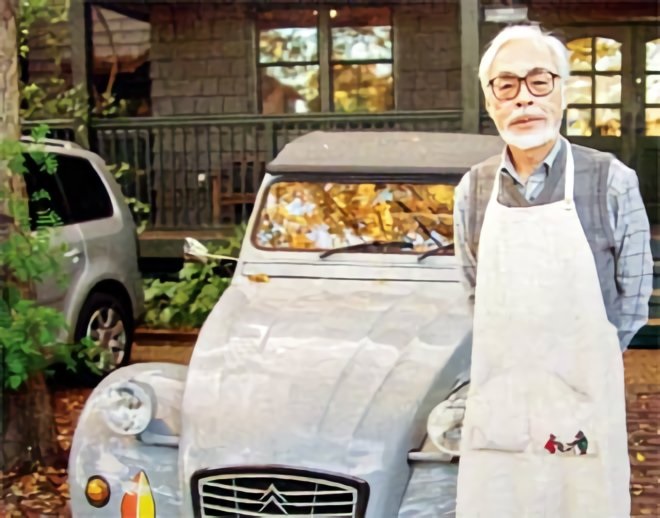
How the Citroen 2CV Inspires Award-Winning Filmmaker Hayao Miyazaki
Movies have created quite a few automotive icons. The Fast and Furious films have enshrined several. But it’s not only live-action movies that have star cars. For instance, a souped-up classic Fiat 500 is the vehicle of choice for the eponymous protagonist of the Lupin the Third anime. One of the early Lupin movies, The Castle of Cagliostro, features a chase scene with it. Said film is also the directorial debut of award-winning Japanese filmmaker Hayao Miyazaki. And while Miyazaki doesn’t drive a 500 himself, he does drive what is arguably the French equivalent: a Citroen 2CV.
What is the Citroen 2CV?
Although the Citroen 2CV came out in 1948, Classic & Sports Car reports the car’s development predates WWII. Although it looks rather simplistic and basic, even for a classic car, Top Gear reports this was intentional. And despite its looks, as Automobile Magazine explains, the 2CV’s designer actually had some rather strict design requirements. So much effort went into this car, that the prototypes were dismantled and hidden so Nazi soldiers couldn’t find them.
The Citroen 2CV’s main intended customers were farmers, which at the time were a large part of France’s workforce. So, any vehicle which they bought needed to be able to go over bumpy roads and fields. Not only that, but it had to do so while carrying people and cargo.
Citroen’s VP and Chief of Engineering and Design, Pierre-Jules Boulanger, dictated that the 2CV be able to carry 4 people and up to a 110-lb payload. But that wasn’t the only mandate. Boulanger also required the car to be able to cross a plowed field at speed with a basket of eggs in the backseat. Oh, and do so without breaking any of them. The car also had to be “cheaper to run than a horse”, Silodrome reports, and get 80 mpg.
Initially, the 2CV was powered by a 9-hp 375cc air-cooled two-cylinder, good for a 40-mph top speed. But by the time it went out of production in 1990, the engine had grown to 602cc, with about 30 hp and a roughly 70-mph top speed.
But Hayao Miyazaki doesn’t drive his Citroen 2CV to speed. He also doesn’t drive it for its interesting features, like the removable bench back seat.
Hayao Miyazaki’s Citroen 2CV story
In many ways, Autoweek reports, the Citroen 2CV is a flawed car. The two-cylinder engine isn’t exactly quiet, and the 2CV’s extremely comfortable suspension means it wallows in corners. It has no heater, nor even a fan.
But its basic nature is exactly why Miyazaki continues to drive a 2CV ever since he was a college student in the 60s. He even named his personal studio, Atelier Nibariki, after the car. ‘Nibaraiki’ means ‘2 horsepower’ in Japanese; ‘2CV’ stands for ‘2 chevaux-vapeur’, or ‘2 steam horses’ in French.
Miyazaki spoke about his car in a 2014 interview. He said, “With it, I tremble with cold in winter and I die of heat in summer. It is in perfect osmosis with my nature and with my workshop installed at the bottom of a wood.” His Studio Ghibli films, like Nausicca and the Valley of the Wind and Princess Mononoke, heavily feature themes of connecting with nature. It’s hard to top a 2CV in that regard, especially with its removable canvas roof and doors. The doors and roof aren’t the only way the Citroen apes the Jeep Wrangler, though.
For one, there was a four-wheel-drive Citroen 2CV. Only, like that Volkswagen Golf Pikes Peak racer, it didn’t actually have a 4WD system installed. Instead, it got 2 engines: one in front, one in the back.
But even without that 2nd engine, 2CVs are remarkably resilient. One family, Hagerty reports has driven over 25,000 miles around the world in a 2CV. The only repairs they’ve had to make are a fan-blade replacement and a bracket repair.
Getting one of your own

From 1948-1990, Citroen made roughly 9 million 2CVs, selling them all over the world. Not only are they fairly plentiful, but there are also numerous clubs able to support potential owners. And the cars themselves, even the best-condition ones, are fairly cheap.
The single most-expensive 2CV sold on Bring a Trailer was a restored example that went for $22,000 in 2018. But apart from the Sahara, most 2CVs go for significantly less than that. It’s possible to find a decent-condition example for $10,000 on BaT.
Follow more updates from MotorBiscuit on our Facebook page.


